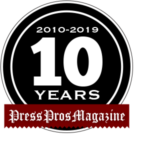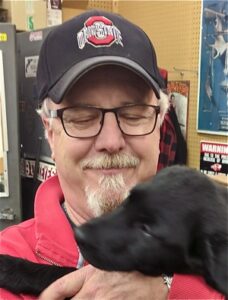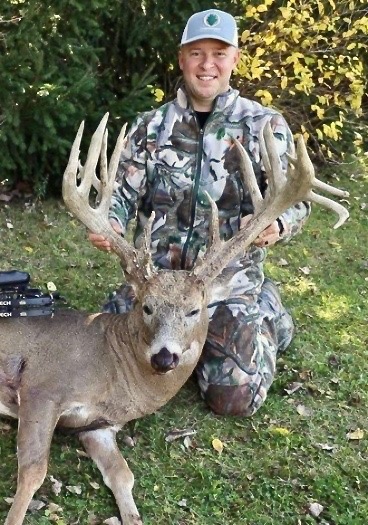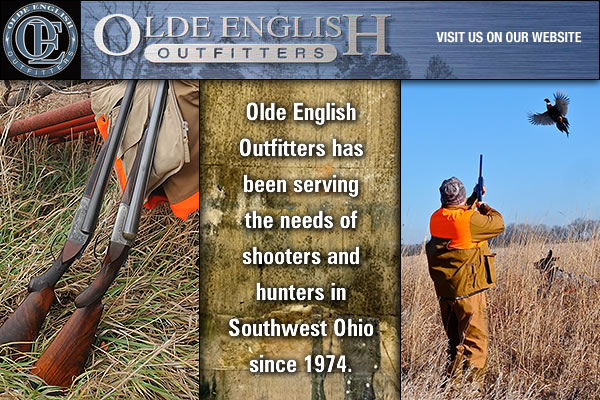Ohio’s whitetail bucks are getting bigger and it’s no one’s imagination. Enforcement of hunting laws and smart management have a lot to do with it. And hunters are leading the way.
By Jim Abrams for Press Pros
 Does it seem to you that every year Ohio’s whitetail bucks seem to be getting bigger? It sure does to me and there’re plenty of proud hunters that prove it annually. The most recent was Matt Brunswick, a K-9 handler and officer for the Hancock County Sheriff’s Dept.
Does it seem to you that every year Ohio’s whitetail bucks seem to be getting bigger? It sure does to me and there’re plenty of proud hunters that prove it annually. The most recent was Matt Brunswick, a K-9 handler and officer for the Hancock County Sheriff’s Dept.
Whether it’s his family, his job or his hunting; Matt is very conscientious about working at spending the time required so that success with each is not an accident. Patterning and identifying deer on the property, hours of scouting and improving the habitat are his keys – but those efforts aren’t as atypical as they may have once been.
 As a teenage hunter and later as a wildlife officer, I’ve spent a lot of time around deer and deer hunters. From the early 1970’s statewide deer population of fewer than 50,000 animals to today’s number that’s more than ten times that figure, the population has certainly evolved – but so have hunting regulations and the hunter.
As a teenage hunter and later as a wildlife officer, I’ve spent a lot of time around deer and deer hunters. From the early 1970’s statewide deer population of fewer than 50,000 animals to today’s number that’s more than ten times that figure, the population has certainly evolved – but so have hunting regulations and the hunter.
Early laws were designed to protect antlerless deer which put more pressure on the remaining bucks. The goal was to allow the deer population to grow. This limited the number of deer available for harvest and many hunters felt an urgency to kill the first buck within range. The end result was that fewer deer were reaching trophy class. Still, Ohio was quickly developing a reputation for nurturing above average Midwestern bucks.
As the deer population grew and expanded, the Division of Wildlife implemented management permits to take limited numbers of antlerless deer from selected counties to control those burgeoning populations. This relaxation of harvest restrictions took some of the stress off of the buck population which in turn had a higher survival rate. Even so, the change was met with some hostility from rural landowners and deer hunters who felt killing doe deer was unwarranted.
 As the years passed, deer populations continued to increase. When developing biological data was tabulated, a far more liberal antlerless attitude ripened among biologists while hunters and landowners had grown to understand management goals. Multiple deer limits became the norm. The doe, once considered an off-limits deity in the hunter’s mind, became a staple of filling freezers; an important change of mindset.
As the years passed, deer populations continued to increase. When developing biological data was tabulated, a far more liberal antlerless attitude ripened among biologists while hunters and landowners had grown to understand management goals. Multiple deer limits became the norm. The doe, once considered an off-limits deity in the hunter’s mind, became a staple of filling freezers; an important change of mindset.
When hunters were no longer limited to one deer per license year, hunting habits changed. That old adage, “You can’t eat antlers,” began to ring especially true. Even with the restriction of one buck per hunter per year, hunters could harvest venison while also becoming more selective. Allowing smaller bucks to pass had become an investment and not perceived as a sacrifice.
During this time there was also a shift in the preferred hunting methods. Recurve and long bows had their numbers supplemented by both compound bows and crossbows which opened that hunting season to a wider range of participants. The archery ranks grew.
The unobtrusive silence of archery became especially important close to urbanized areas. Much of this land, which is less than ideal for gun-hunting, is perfect for bowhunting. It allows those deer to become more hunter-accessible which can help landowners deal with deer related damage.

Matt Brunswick’s non-typical whitetail buck scored 252 (green) and is the largest ever taken in Hancock County.
Hunters have also become more sophisticated in their approach to learning about deer conservation. Organizations like the National Deer Association, Whitetails Unlimited and Black Swamp Bucks dedicate their time to educating landowners and hunters.
Magazines like North American Whitetail and Buckmasters are easily found at newsstands. Habitat and nutritional recommendations from the Division of Wildlife, Mossy Oak’s Game Keepers, Pheasants Forever and online resources has brought proven wildlife management techniques within reach of landowners and hunters.
The resulting quality deer management approach to habitat and deer harvest has resulted in a group of very selective deer hunters looking for the trophy of a lifetime every year…and they’re getting it done. They realize that management and restraint can result in future opportunities.
Hunters also deploy game cameras to photograph wildlife year-round to pattern movements and keep the user connected to the wildlife and land that they love. As a bonus, these hidden cameras document incursions by trespassers; information that’s often relayed to wildlife officers for action. This helps limit illegal killing and harassment of wildlife.
Matt Brunswick harvested an impressive deer. Using the official scoring method of the Ohio Big Bucks Club, it scored 252. If it holds close after the required 60-day drying period, it will be the largest non-typical buck ever taken in the county and in the top half-dozen longbow harvests ever taken in Ohio. It isn’t Matt’s first record-book buck either, having landed three others in its pages. I doubt this one will be his last; Ohio is the Buckeye State.
“Luck is what happens when preparation meets opportunity.” – Seneca
Abrams is a retired wildlife officer supervisor for the state Division of Wildlife in Findlay. He can be reached at P.O. Box 413, Mount Blanchard, OH 45867-0413 or via e-mail at jimsfieldnotes@aol.com.

